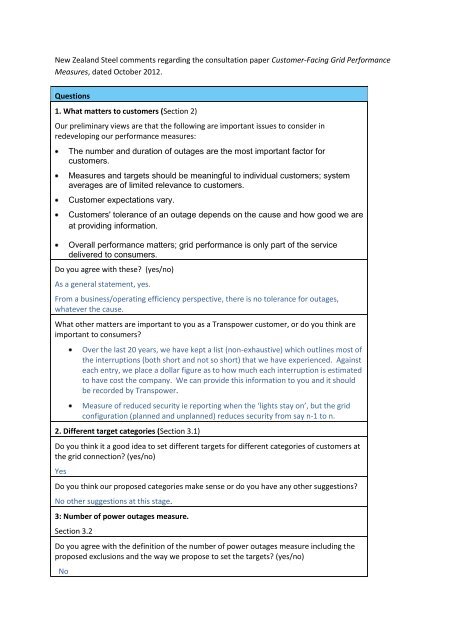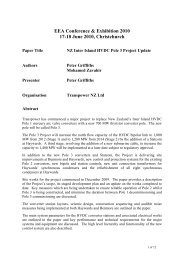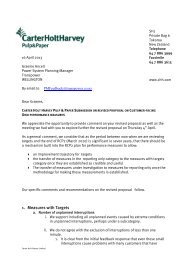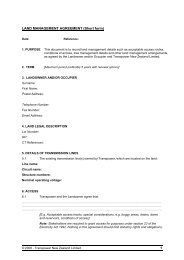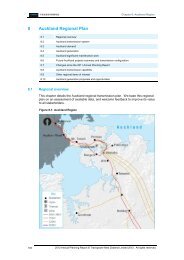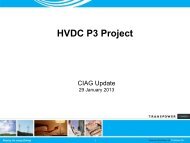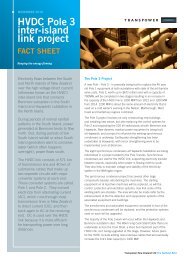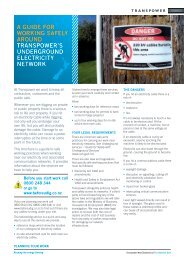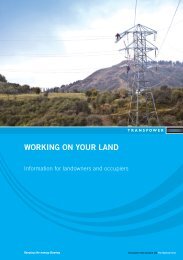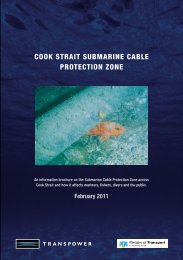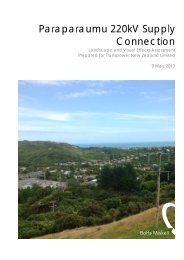New Zealand Steel comments regarding the ... - Transpower
New Zealand Steel comments regarding the ... - Transpower
New Zealand Steel comments regarding the ... - Transpower
You also want an ePaper? Increase the reach of your titles
YUMPU automatically turns print PDFs into web optimized ePapers that Google loves.
<strong>New</strong> <strong>Zealand</strong> <strong>Steel</strong> <strong>comments</strong> <strong>regarding</strong> <strong>the</strong> consultation paper Customer-Facing Grid PerformanceMeasures, dated October 2012.Questions1. What matters to customers (Section 2)Our preliminary views are that <strong>the</strong> following are important issues to consider inredeveloping our performance measures:The number and duration of outages are <strong>the</strong> most important factor forcustomers.Measures and targets should be meaningful to individual customers; systemaverages are of limited relevance to customers.Customer expectations vary.Customers' tolerance of an outage depends on <strong>the</strong> cause and how good we areat providing information.Overall performance matters; grid performance is only part of <strong>the</strong> servicedelivered to consumers.Do you agree with <strong>the</strong>se? (yes/no)As a general statement, yes.From a business/operating efficiency perspective, <strong>the</strong>re is no tolerance for outages,whatever <strong>the</strong> cause.What o<strong>the</strong>r matters are important to you as a <strong>Transpower</strong> customer, or do you think areimportant to consumers?Over <strong>the</strong> last 20 years, we have kept a list (non-exhaustive) which outlines most of<strong>the</strong> interruptions (both short and not so short) that we have experienced. Againsteach entry, we place a dollar figure as to how much each interruption is estimatedto have cost <strong>the</strong> company. We can provide this information to you and it shouldbe recorded by <strong>Transpower</strong>.Measure of reduced security ie reporting when <strong>the</strong> ‘lights stay on’, but <strong>the</strong> gridconfiguration (planned and unplanned) reduces security from say n-1 to n.2. Different target categories (Section 3.1)Do you think it a good idea to set different targets for different categories of customers at<strong>the</strong> grid connection? (yes/no)YesDo you think our proposed categories make sense or do you have any o<strong>the</strong>r suggestions?No o<strong>the</strong>r suggestions at this stage.3: Number of power outages measure.Section 3.2Do you agree with <strong>the</strong> definition of <strong>the</strong> number of power outages measure including <strong>the</strong>proposed exclusions and <strong>the</strong> way we propose to set <strong>the</strong> targets? (yes/no)No
QuestionsDo you have any <strong>comments</strong> or suggestions?Over <strong>the</strong> last 20 or so years, we had had far more problems with “short term outages”than <strong>the</strong> longer ones. We experience <strong>the</strong>se “short term outages” as voltage dips ormomentary interruptions and <strong>the</strong>n a second or so later, <strong>the</strong> voltage is back to normal, but<strong>the</strong> damage has been done. Most of <strong>the</strong>se disturbances come via <strong>the</strong> <strong>Transpower</strong>network from <strong>the</strong> local lines company network, but some of <strong>the</strong>m have originated fromfaults on <strong>Transpower</strong> assets at <strong>the</strong> Otahuhu substation, Penrose substation and various HVlines in <strong>the</strong> Auckland Isthmus area.So we do not agree with <strong>Transpower</strong>’s contention that outages of less than one minutelong be excluded from <strong>the</strong> measure. More specifically, we would like all disturbances thathave originated from <strong>Transpower</strong> equipment be part of <strong>the</strong> overall measure.Do you think we should include or exclude outages caused by extreme conditions such asearthquake or snow storm?They should be included, but possibly with a rider explaining <strong>the</strong> severity of <strong>the</strong> causingevent.4: Duration of power outagesSection 3.3Do you agree with <strong>the</strong> definition of <strong>the</strong> duration of power outages measure including <strong>the</strong>proposed exclusions and <strong>the</strong> way we propose to set <strong>the</strong> targets? (yes/no)As per <strong>the</strong> above, we don’t agree with <strong>the</strong> non-measurement of sub one minute outages.Do you have any <strong>comments</strong> or suggestions?NoWhat are your views on how we should measure durations where customers backfeed orload manage during a transmission problem.The duration should be from when <strong>the</strong> customer losses supply to when <strong>the</strong> customer hasfull supply restored. ie no load management is required, but supply may be by back-feedor alternate configuration.5: Information provisionSection 3.4Do you think <strong>the</strong> information provision measures we propose will be useful? (yes/no)YesDo you have any <strong>comments</strong> or suggestions on <strong>the</strong> proposed measures and targets?Information on economic impact should be includedInclude measures on reduced security – planned and unplanned (see Q1).6: Transmission outages compared to distributionSection 3.5Do you think a measure to compare transmission and distribution performance is useful?(yes/no)Yes
QuestionsIf so, which of <strong>the</strong> two measures is <strong>the</strong> most important?For NZ <strong>Steel</strong>, <strong>the</strong> transmission performance is more important


